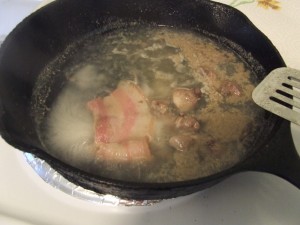by David Cecelski
“Save us some pluck,” the ladies at Fishtowne Seafood in Beaufort often tell the guys behind the counter. They want them, they mean, to save the gizzards and livers from a popular local saltwater fish called jumping mullet when they clean them for other customers who do not share their fondness for fish organs.
Long attached to the sea, many people here in Carteret County hold jumping mullet’s gizzards and livers in high esteem. The jumping mullet fishery in Carteret County was the largest saltwater fishery in the American South for many years in the 19th century. The fishery—especially the salt mullet fishery— continued to boom well into the 1950s, when people still referred to the local railroad as the “Old Mullet Line.”
You’ll still see plenty of mullet leaping in local waters, but the commercial fishery has just about disappeared. However, many of us have kept a fierce attachment to the fish in our kitchens. Fried or slow-cooked over coals, it’s still one of my favorite seafood dishes.
Most locals don’t eat the gizzards and livers, but many old timers still do, usually on the side of a grilled jumping mullet and sometimes alongside the baked or fried roe, too.
At Fishtowne Seafood, I purchased several jumping mullet and asked the young man taking my order to save the pluck for me, too. After he cut open their bellies, he removed the gizzards and livers. He washed them and, with a sharp knife, he sliced open the gizzards and cleaned the gristle out. Then he placed them and the livers in a little plastic bag for me to take home.
Here’s the recipe for pluck that I use. It’s from Mrs. Lillie Lupton of Lenoxville, an old neighborhood outside Beaufort that used to be home to many fishing families. I found it in a local cookbook called Seafood Cooking for Carteret County Kitchens, which was published by the Carteret County Extension and Community Association Clubs to raise scholarship funds for high school students in 1965.
Here’s Mrs. Lupton’s recipe: Start by trying out the grease from 2 or 3 strips of salt pork. Then separate the gizzards from the livers. Add the gizzards to the fried salt pork and cover with water. Cook the gizzards until tender and all the water has evaporated. Finally, add the livers and stir constantly until brown.
“Keep stirring,” Bill Rice, Fishtowne Seafood’s owner/operator, cautioned me as I was leaving.
I’m not a big fan of any kind of liver and I’ve never taken to jumping mullet’s livers, either. But the gizzards made for delightful, tasty little morsels, rich and salty, but surprisingly earthy, too, reminiscent of mushrooms I’ve had. I’d eat them with my jumping mullet any day.
———-
For more about Fishtowne Seafood and its visionary owner/operator, Bill Rice, see www.fishtowneseafood.com. Bill has been a pioneer in Carteret Catch, a program that champions the use of locally-caught seafood in restaurants, and also in a CSF—Community Supported Fishery—that brings fresh fish and shellfish to members in Durham and Raleigh. For more about the CSF, seewww.walking-fish.org.
copyright, 2012.

Leave a Reply